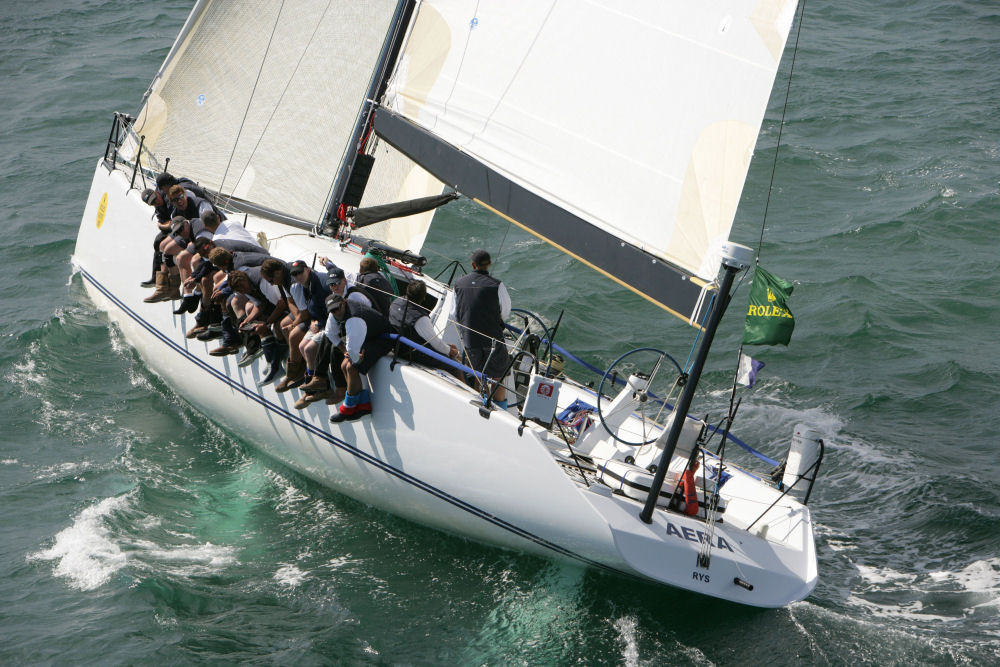
Rolex Fastnet Race 2005 - Update
by Rolex Media Centre 8 Aug 2005 20:34 BST

Nik Lykiardopulo's Aera in the Rolex Fastnet Race 2005 © Daniel Forster / Rolex
BIG BOATS MAKE HAY WHILE THE LITTLE ONES WALLOW
ICAP Maximus maintains her lead in the Rolex Fastnet Race and could reach the Fastnet Rock before sunset this evening. At 1400 hours earlier this afternoon, a helicopter pilot logged the 100-foot New Zealand Maxi as making 10 knots boatspeed in just 6 knots of breeze. With just 65 miles to the Rock off the south-western tip of Ireland, the boat's progress appears to be exceeding the predictions of the navigator Mike Quilter. Without the benefit of a helicopter's viewpoint of the Celtic Sea, the round-the-world-race veteran could only draw his conclusions from the weather data he was receiving, which suggested the high pressure system could kill the breeze dead, and that ICAP Maximus would not reach the Rock for a long time yet.
However the lightweight canting-keeled Maxi appears to be one of the few boats enjoying any sort of useable breeze right now. This afternoon she was seven miles ahead of Skandia Wild Thing, with the Volvo Open 70 Movistar another half-mile behind the Aussie Maxi. Some miles further back was the Volvo Ocean 60 ABN Amro and two Open 60s locked in a close duel that has been going on since the Solent. The most recent update put Pindar as having regained the lead from Sill. While the bigger boats continue to make measurable progress, the majority of the fleet is still scattered along the south-west coast of England, trying to eke out what speed they can from the little breeze they can catch in their sails.
Nick Haigh's Farr 40 Too Steamy has been outperforming other boats of her size, but was wallowing off Lands End in a virtual flat calm. A few miles further south, Simon Le Bon and his crew on the old Maxi, Arnold Clark Drum, were making just 2 knots speed in 2 knots of wind. But crewman Phil Wade said they were enjoying the sun and the calm sea, a stark contrast to the raging gale in this race 20 years ago, when Drum capsized and the whole crew's lives were put in danger. "It's chalk and cheese," said Wade.. "Today it's a beautiful sunny day, we're in our shorts with shirts off. Twenty years ago, we had three reefs in the mainsail, a Code 5 genoa [the smallest sail for heavy weather], it was driving rain with one mile visibility. So we're very happy to be back here in different circumstances." Le Bon celebrated passing the point where Drum capsized, off the Falmouth coast, with a bottle of champagne this afternoon.
Alcohol seems to lie at the heart of Berrimilla's success in this race so far. This doublehanded 33-footer, sailed by Australian friends Alex Whitworth and Peter Crozier, is beating boats far larger. In the absence of other crewmembers, Whitworth admits to "consulting with Dr Murphy in the day and Dr Gordon in the evening", referring to his two morale-boosting tipples. There isn't much rest for these two sailors, as the three hours on/ three hours off arrangement isn't always feasible when the sailing gets difficult. "We're trying to run with a very flat spinnaker at the moment, which is taking all of our concentration. But we just passed one of the Global Challenge boats [more than twice Berrimilla's length], so we're going well."
Earlier in the day, the two of the rivals for IRC handicap victory had gone their separate ways, with Patches staying inshore while Aera gybed offshore in search of more breeze. Patches skipper Ian Walker had been very uncertain about the outcome but was relieved to discover his inshore strategy had paid off later on in the day, when both boats converged back towards the course gate at the Scilly Isles. "I reckon we have a three- or four-mile lead on Aera now," he said. "We are sailing in 5 knots breeze with the spinnaker, on a course that is taking almost straight to the Fastnet Rock. As long as the breeze keeps us going downwind then we should be fine, but then of course we've got to turn around and come back upwind again."
The Patches crew has a sweepstake bet running on board, with bets taken for the estimated time of arrival (ETA) at the finish in Plymouth. Walker's estimate is the most pessimistic, but he's happy about that. "It costs £10 to enter, and you get a chance to revise your ETA every day, provided you pay another £5. I've just paid my £5 and I'm very happy to be holding the bet for the latest finish time. We've got a long, long way to go yet."
The Rolex Fastnet Race entails 608 miles of racing from Cowes to Plymouth, via the Fastnet Rock off the southern tip of Ireland. In addition to the two main prizes - the Fastnet Challenge Cup and the Fastnet Rock Trophy, there are more than 30 trophies to be awarded at the conclusion of this year's race. The prizegiving will take place at the Royal Citadel, home of 29 Commando Regiment Royal Artillery, in Plymouth on Friday 12th August.
Further information about the RORC and the Rolex Fastnet Race can be found at www.rorc.org